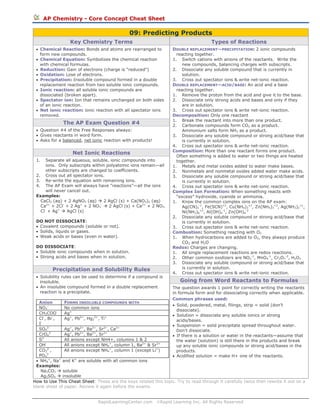
Predicting products cheat sheet
- 1. AP Chemistry - Core Concept Cheat Sheet 09: Predicting Products Key Chemistry Terms Types of Reactions • Chemical Reaction: Bonds and atoms are rearranged to form new compounds. • Chemical Equation: Symbolizes the chemical reaction with chemical formulas. • Reduction: Gain of electrons (charge is “reduced”) • Oxidation: Lose of electrons. • Precipitation: Insoluble compound formed in a double replacement reaction from two soluble ionic compounds. • Ionic reaction: all soluble ionic compounds are dissociated (broken apart). • Spectator ion: Ion that remains unchanged on both sides of an ionic reaction. • Net ionic reaction: ionic reaction with all spectator ions removed. The AP Exam Question #4 • Question #4 of the Free Responses always: • Gives reactants in word form. • Asks for a balanced, net ionic reaction with products! Net Ionic Reactions 1. Separate all aqueous, soluble, ionic compounds into ions. Only subscripts within polyatomic ions remain—all other subscripts are changed to coefficients. 2. Cross out all spectator ions. 3. Re-write the equation with remaining ions. 4. The AP Exam will always have “reactions”—all the ions will never cancel out. Examples: CaCl2 (aq) + 2 AgNO3 (aq) 2 AgCl (s) + Ca(NO3)2 (aq) Ca2+ + 2Cl- + 2 Ag+ + 2 NO32 AgCl (s) + Ca2+ + 2 NO3Cl- + Ag+ AgCl (s) DO NOT DISSOCIATE: • Covalent compounds (soluble or not). • Solids, liquids or gases. • Weak acids or bases (even in water). DO DISSOCIATE: • Soluble ionic compounds when in solution. • Strong acids and bases when in solution. Precipitation and Solubility Rules • Solubility rules can be used to determine if a compound is insoluble. • An insoluble compound formed in a double replacement reaction is a precipitate. DOUBLE REPLACEMENT—PRECIPITATION: 2 ionic compounds reacting together. 1. Switch cations with anions of the reactants. Write the new compounds, balancing charges with subscripts. 2. Dissociate any soluble compound that is currently in solution. 3. Cross out spectator ions & write net-ionic reaction. DOUBLE REPLACEMENT—ACID/BASE: An acid and a base reacting together. 1. Remove the proton from the acid and give it to the base. 2. Dissociate only strong acids and bases and only if they are in solution. 3. Cross out spectator ions & write net-ionic reaction. Decomposition: Only one reactant 1. Break the reactant into more than one product. 2. Carbonate compounds form CO2 as a product. Ammonium salts form NH3 as a product. 3. Dissociate any soluble compound or strong acid/base that is currently in solution. 4. Cross out spectator ions & write net-ionic reaction. Composition: More than one reactant forms one product. Often something is added to water or two things are heated together. 1. Metals and metal oxides added to water make bases. 2. Nonmetals and nonmetal oxides added water make acids. 3. Dissociate any soluble compound or strong acid/base that is currently in solution. 4. Cross out spectator ions & write net-ionic reaction. Complex Ion Formation: When something reacts with “excess” hydroxide, cyanide or ammonia. 1. Know the common complex ions on the AP exam: Ag(CN)2-1, Fe(SCN)+2, Cu(NH4)3+2, Zn(NH4)3+2, Ag(NH3)2+1, Ni(NH3)6+2, Al(OH)4-1, Zn(OH)4-2 2. Dissociate any soluble compound or strong acid/base that is currently in solution. 3. Cross out spectator ions & write net-ionic reaction. Combustion: Something reacting with O2 1. When hydrocarbons are added to O2, they always produce CO2 and H2O Redox: Charges are changing. 1. All single replacement reactions are redox reactions. 2. Other common oxidizers are NO3-1, MnO4-1, Cr2O7-2, H2O2 3. Dissociate any soluble compound or strong acid/base that is currently in solution. 4. Cross out spectator ions & write net-ionic reaction. Going from Word Reactants to Formulas The question awards 1 point for correctly writing the reactants in formula form and for dissociating correctly when applicable. Common phrases used: • Solid, powdered, metal, filings, strip = solid (don’t dissociate). • Solution = dissociate any soluble ionics or strong acids/bases. • Suspension = solid precipitate spread throughout water. Don’t dissociate. • If there is a solution or water in the reactants—assume that the water (solution) is still there in the products and break up any soluble ionic compounds or strong acid/bases in the products. • Acidified solution = make H+ one of the reactants. Anion FORMS INSOLUBLE COMPOUNDS WITH NO3No common ions CH3COOAg+ Cl-, Br-, Ag+, Pb2+, Hg22+, Ti+ ISO42Ag+, Pb2+, Ba2+, Sr2+, Ca2+ CrO42Ag+, Pb2+, Ba2+, Sr2+ 2S All anions except NH4+, columns 1 & 2 OHAll anions except NH4+, column 1, Ba2+ & Sr2+ CO32-, All anions except NH4+, column 1 (except Li+) PO43• NH4+, Na+ and K+ are soluble with all common ions Examples: Na2CO3 soluble Ag2SO4 insoluble How to Use This Cheat Sheet: These are the keys related this topic. Try to read through it carefully twice then rewrite it out on a blank sheet of paper. Review it again before the exams. RapidLearningCenter.com ©Rapid Learning Inc. All Rights Reserved
